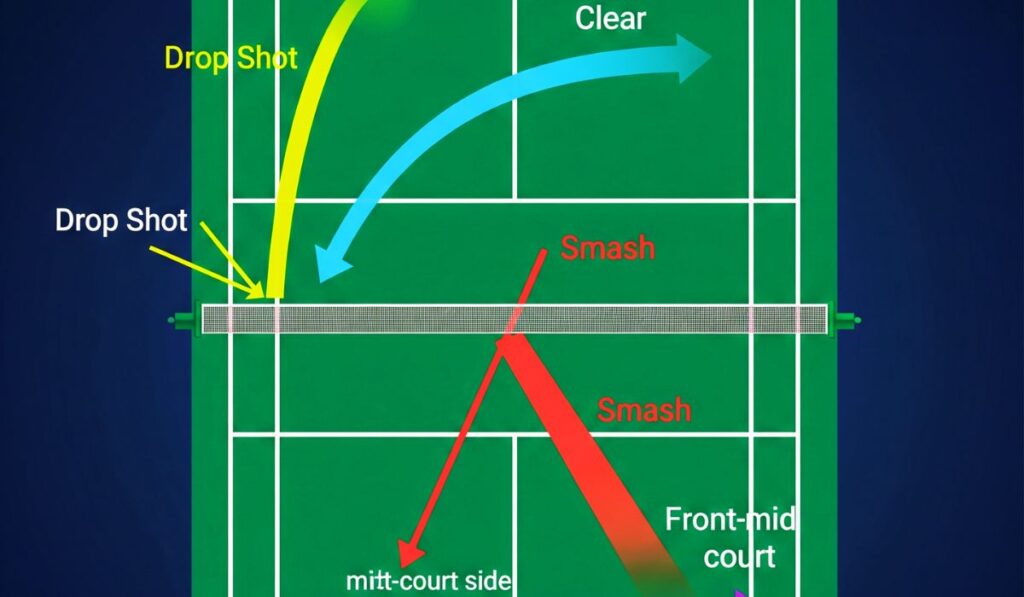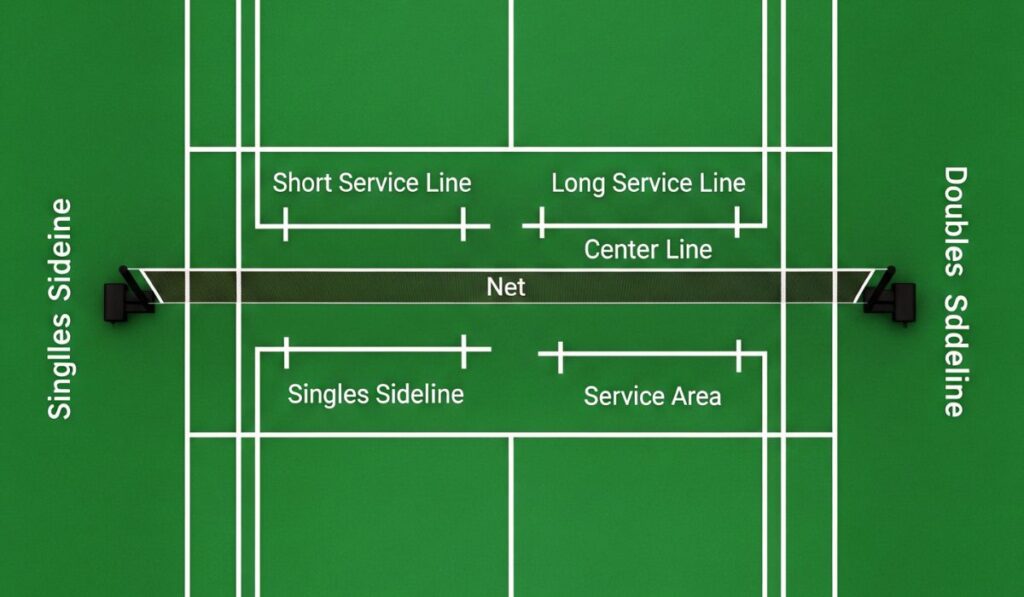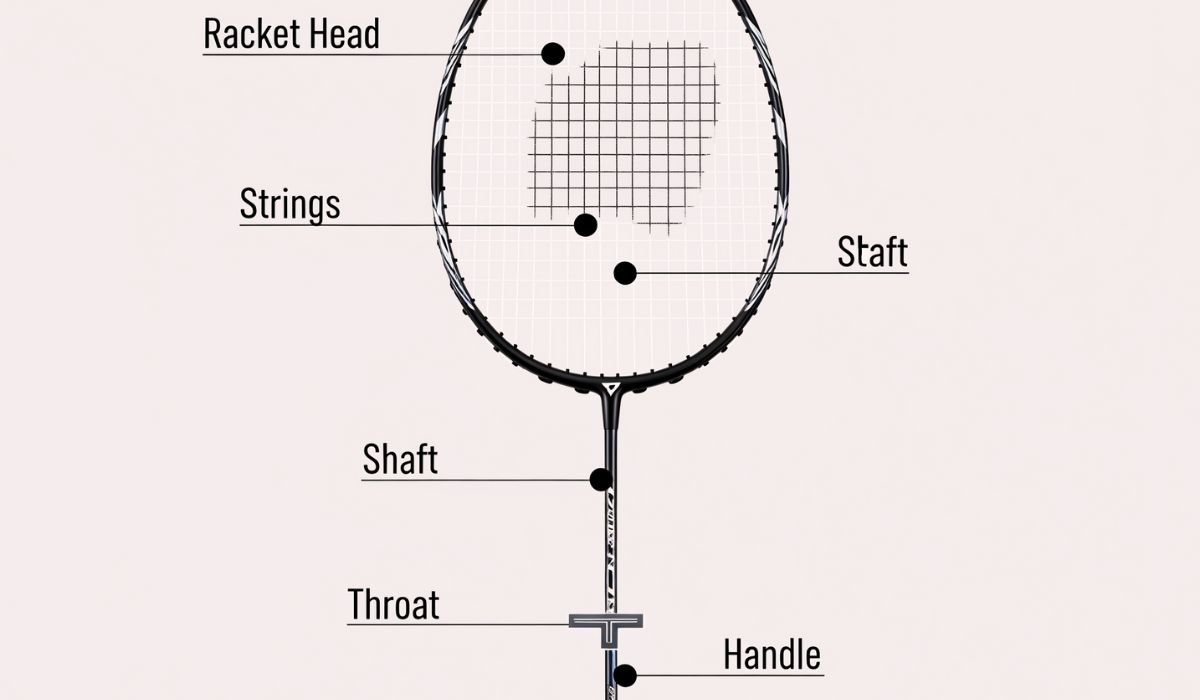“Why Most Players Misunderstand These Badminton Terms – And How Knowing Them Gives You an Unfair Advantage”
Badminton may seem simple from a distance — a swift shuttle gliding back and forth over a net, light as a feather and yet powerful enough to decide destinies. But beneath that graceful dance lies a world of precise language, specialized phrases, and hidden meanings that shape how the game is played, taught, and understood. Without these terms used in badminton, a player would be like a traveler without a map, wandering a court without truly understanding the terrain.
If you’ve ever stepped into a Terms used in badminton hall and heard players shout “clear!” or “smash!” or “drive!”, you’ve already brushed against this unique vocabulary. These aren’t just casual words — they are signals, strategies, and sparks of adrenaline woven into the sport’s soul.
In this article, we will dive deep into these Terms used in badminton, not as cold definitions, but as living, breathing parts of the game. We’ll uncover the artistry behind them, the feelings they evoke, and the way they shape your experience whether you’re a beginner feeling the shuttle’s first touch or a seasoned competitor chasing championship points.
Why Knowing the Terms in Badminton is a Game-Changer
Learning the terms used in badminton is more than memorizing definitions; it’s like unlocking the hidden rhythm of the sport. Imagine trying to dance without knowing the names of the steps — you might move, but you’d always be a beat behind.
When a coach shouts “net kill!” in the middle of a heated rally, Terms used in badminton understanding exactly what that means can mean the difference between scoring a point and giving one away. These terms are the shorthand of success — a shared code between players that keeps communication fast and precise, especially under pressure.
Terms used in badminton The beauty of this language is that it connects every player, from local club enthusiasts to Olympic champions. Whether in an indoor hall under bright white lights or on a breezy backyard court, these words carry the same heartbeat.
Clear – The High Arc of Escape and Control
Terms used in badminton, a clear is a shot played high and deep into the opponent’s court, often to push them to the back boundary line. On paper, it’s just a defensive or rallying shot. In reality, it feels like a moment of sweet relief — the kind of shot you play when the game is suffocating you and you need breathing space.
The shuttle rises, almost in slow motion, tracing a graceful arc against the ceiling or the open sky. For a brief moment, time stretches. You see your opponent retreat, their heels scraping the court, their balance shifting backward. It’s your chance to reset the rally, to turn chaos into control.
Smash – The Lightning Strike of Badminton
The smash is badminton’s most electrifying weapon — a shot hit sharply downward into the opponent’s court at blistering speed. The moment you strike the shuttle, there’s a crisp, satisfying crack, like a whip snapping through the air.
Terms used in badminton It’s not just a shot; it’s an act of dominance. The shuttle dives toward the floor so fast that your opponent has mere fractions of a second to react. Every smash carries a jolt of adrenaline, a surge of confidence, and sometimes, the delicious sting of making your opponent stumble.
But beware — the smash can be intoxicating. Overuse it without precision, and you’ll burn your energy too quickly, leaving yourself vulnerable.
Drop Shot – The Whisper That Breaks Defenses
If the smash is a thunderclap, the drop shot is a whisper — soft, deceptive, and dangerously effective. You guide the shuttle just over the net, making it fall like a silk scarf drifting to the floor.
A good drop shot makes your opponent run forward in panic, stretching every muscle to reach it before it kisses the ground. It’s a move of elegance and cruelty combined — beautiful to watch, agonizing to defend against.

Drive – The Flat, Furious Exchange
A drive in badminton is a flat, fast shot that skims just above the net, forcing opponents into quick reactions. When two players trade drives, it’s like a sword fight — sharp, rapid, and unrelenting.
The rally becomes a blur of motion and reflexes. Each shuttle zips across the net with no time to think, only to react. In those moments, the world narrows to the space between your racket and the shuttle, and every heartbeat counts.
Net Kill – The Instant Punishment
A net kill is a lethal move executed when the shuttle floats too high near the net. It’s swift, almost merciless — a flick of the wrist that slams the shuttle straight down before your opponent can blink.
The sound it makes is different, more final — like the thud of a locked door. You’ve ended the rally on your terms, snatching the point with a ruthless flourish.
Fault – The Invisible Trap Terms used in badminton
In badminton, a fault isn’t just a mistake — it’s a silent thief that steals your points. It could be stepping on the service line while serving, hitting the shuttle before it crosses the net, or sending it out of bounds.
Each fault feels like a sting because it’s entirely avoidable. And yet, under the tension of a close match, even experienced players fall victim to them. It’s the sport’s quiet reminder that skill is nothing without control.
Love – The Starting Point of Every Battle
Terms used in badminton Strangely enough, in badminton, the term “love” means zero. At the start of every game, when the score is “love-all,” it’s a moment of purity — no one has an advantage, no one has a lead.
But from that zero, legends are built. The scoreboard slowly fills, each point a story in itself, and “love” becomes a distant memory.
Deuce – The Nerve-Shattering Equalizer
When the score reaches a tie at 20-20 in badminton, it’s called deuce. At that moment, the air feels thicker, the silence between rallies heavier. One mistake could end it all, one bold shot could seal the win.
In deuce, you can almost hear your heartbeat over the shuffle of feet and the squeak of shoes on the court. Every rally feels like walking a tightrope.
The Enchanting Rhythm of ‘Clear’ – The Lift That Touches the Sky
When a badminton player executes a clear, it is more than just a defensive move. It’s an act of buying time, of sending the shuttle soaring high above like a silver feather floating against the lights. You can almost hear the gasp of the crowd as it reaches its peak, hangs in a moment of serene suspension, and then descends, like a falling leaf, deep into the opponent’s court. The term may sound simple, but in its essence, a clear carries both relief and strategy — it is the heartbeat of rallies, the calm before a calculated storm.
The Seduction of the Smash – Power Unleashed in a Single Stroke
The Terms used in badminton word smash in badminton is not just a term; it’s a promise of impact, a roar in a quiet hall. It is the moment when the racquet arcs down like a hawk diving for prey, and the shuttle hurtles toward the ground with such velocity that the air seems to split. In that instant, time freezes — your eyes trace the blurred white streak, your ears register the sharp pop of contact, and your heart races as you wonder if anyone could possibly defend against it. This is where aggression meets elegance.
Drop Shot – The Whisper in the Storm
In a world of power and speed, the drop shot is a gentle rebellion. It is the deceptive caress of the shuttle that kisses the top of the net and falls delicately, forcing the opponent to sprint forward in desperation. There’s poetry in the drop — a soft sigh after a series of violent exchanges. It’s the move that teaches us that sometimes victory isn’t about force, but about finesse and timing.
The Net Kill – Ruthlessness at Arm’s Length
The Terms used in badminton net kill sounds brutal, and in truth, it is. Performed at the net when the shuttle sits just too high for comfort, it’s the sudden, merciless end to a rally. The racquet strikes downward with precision, the shuttle barely having time to breathe before it kisses the court. In that fleeting moment, the game shifts — confidence surges in the attacker, while the defender tastes defeat.
Drive – The Arrow in Flight Terms used in badminton
The drive is a rally’s pulse-quickening heartbeat. It’s a shot that moves horizontally, skimming just above the net like an arrow on a deadly path. Drives test reflexes, reaction time, and courage. Two players can exchange drives at lightning speed, the shuttle flashing back and forth like sparks in a midnight duel. It’s the moment when instinct overtakes thought, and the crowd feels their own muscles tense as if holding a racquet themselves.
Lift – The Breath of Recovery Terms used in badminton
A lift is a player’s sanctuary, a way to push the shuttle deep into the opponent’s court and reclaim composure. The air carries the shuttle gently upward before it lands far away from danger. But within this calm lies calculation — lifts can lure opponents into smashing too soon or force them into awkward positioning. It’s a shot that reminds us that survival is an art.
Block – The Silent Wall Terms used in badminton
Terms used in badminton When the shuttle comes screaming toward you after a smash, the block is your shield. It is the quiet deflection that absorbs the blow and redirects it, often just over the net. The crowd might barely react to it, but seasoned players know — a perfect block can turn defense into opportunity. There is a meditative stillness in this move, a steadiness that defies panic.
Push Shot – The Gentle Persuasion
Terms used in badminton A push shot doesn’t try to dominate the rally; it simply nudges the shuttle into a space where it belongs. Executed with control rather than force, it’s the badminton equivalent of guiding someone through a door instead of shoving them. In a game of relentless attacks, the push is a reminder of subtlety.
Flick – The Hidden Sting
The flick is deception wrapped in grace. Most often seen in serves or quick exchanges, it’s the sudden upward whip that catches an opponent off-guard. It’s a term that sounds almost playful, but when executed perfectly, a flick is devastating — the opponent’s split-second hesitation becomes your victory.
The Backhand – A Story of Strength in Awkwardness
Few shots are as emotionally charged as the backhand. It is the moment when you turn disadvantage into brilliance. Executed with the wrist’s flick and the arm’s twist, the backhand is often underestimated until it delivers a clean, unexpected winner. Terms used in badminton it makes — sharper, quicker than a forehand — is music to those who master it.
Forehand – The Familiar Warrior
The forehand is comfort, control, and confidence. It’s the stroke most players learn first, yet it remains a weapon throughout their careers. When done well, the forehand feels like an extension of the body, as natural as reaching for something. But it’s more than just familiarity — it’s the foundation upon which entire strategies are built.

Baseline – The Silent Boundary of Destiny
Terms used in badminton, the baseline is not merely a line; it’s the invisible wall that dictates life and death for a rally. Cross it wrongly, and you gift a point. Hit it just right, and you steal the opponent’s breath. It’s the place where power meets precision, where the smallest misjudgment can unravel the greatest rally.
Service – The First Whisper of Battle
Terms used in badminton Every game begins with the service, yet it holds more weight than most realize. The shuttle leaves the server’s hand in a delicate arc, carrying intent and strategy before the rally even begins. Whether it’s a short, teasing serve or a long, deep one, service is the invitation to battle — and how it’s given can set the tone for the entire game.
Fault – The Sting of Misstep
No Terms used in badminton is more bittersweet than fault. It’s the referee’s quiet announcement that something went wrong — a foot over the line, a shuttle that didn’t clear the net, a service too high. Faults are tiny fractures in a player’s confidence, but also lessons carved into memory.
Let – The Breath Between Storms
When a rally is stopped and replayed due to interference or a mishap, it’s called a let. In that pause, players gather their thoughts, adjust their grip, feel the sweat cooling on their skin. A let is both a relief and a suspenseful delay — the audience leaning in, waiting for the next heartbeat of play.
Deuce – The Edge of Madness
A deuce in badminton is electricity in its purest form. At 20-20, the rally becomes more than a rally; it’s a battle of nerve and steel. The crowd feels every muscle tighten, every breath shorten. Players are no longer just hitting a shuttle — they’re trading dreams and fears over a fragile net Terms used in badminton.
Match Point – The Final Curtain Call
The Terms used in badminton match point carries a weight unlike any other. The air grows heavy, the court feels smaller, and the player serving knows that every muscle movement could mean glory or despair. It’s a point that can echo in memory for years.
Rally – The Dance of Persistence
A rally is the heartbeat of badminton, a back-and-forth dance of anticipation and reaction. Each stroke is a brushstroke on a canvas of strategy and athleticism. Long rallies, in particular, feel like sagas — each hit a chapter building toward an ending nobody can predict.
Love – The Innocent Beginning
Terms used in badminton scoring, love means zero. Yet the irony is that it’s also where every game begins — with nothing but potential. The sound of the scorekeeper calling “love-all” is both a fresh start and a reminder that in a few minutes, the court will become a battlefield.

